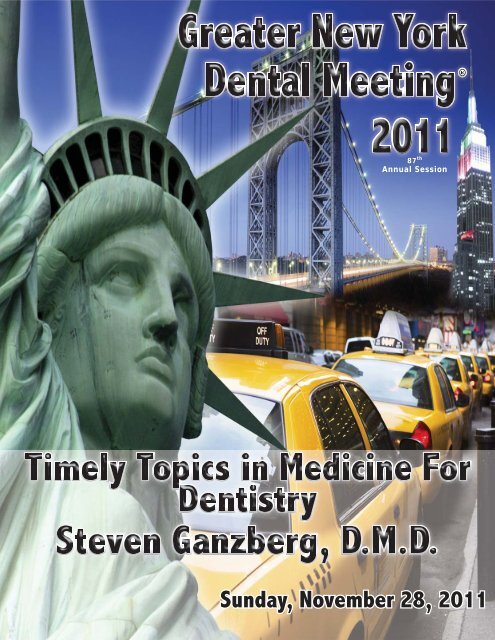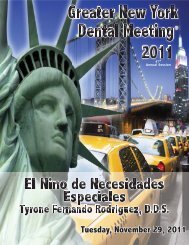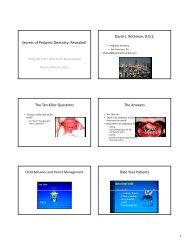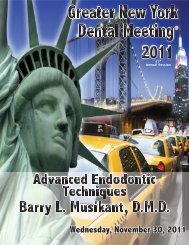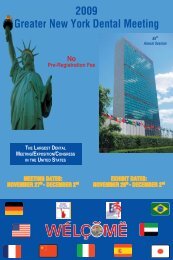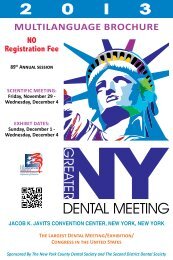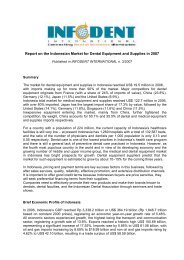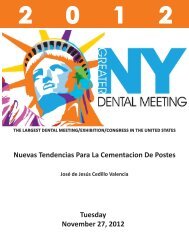Sunday, November 28, 2011 - Greater New York Dental Meeting
Sunday, November 28, 2011 - Greater New York Dental Meeting
Sunday, November 28, 2011 - Greater New York Dental Meeting
You also want an ePaper? Increase the reach of your titles
YUMPU automatically turns print PDFs into web optimized ePapers that Google loves.
87 th<br />
Annual Session<br />
<strong>Sunday</strong>, <strong>November</strong> <strong>28</strong>, <strong>2011</strong>
Welcome to the <strong>Greater</strong> <strong>New</strong> <strong>York</strong> <strong>Dental</strong> <strong>Meeting</strong><br />
<strong>2011</strong><br />
Celebrity Luncheon Speaker<br />
Fourth Annual INVISALIGN®- GNYDM EXPO<br />
4 Days of Programming: <strong>Sunday</strong> - Wednesday<br />
Invisalign Clear Essentials I; Invisalign Clear Essentials II;<br />
Invisalign Advanced Programs & Team Building Courses<br />
Botox/Dysport and<br />
Dermal Filler<br />
Hands-on Workshops<br />
Hands-On Training<br />
Using Botulinum Toxin<br />
(Botox®) To Treat<br />
Dento-Facial Conditions<br />
COURSE DISCLAIMER<br />
4 Days of Seminars &<br />
The <strong>Greater</strong> <strong>New</strong> <strong>York</strong> <strong>Dental</strong> <strong>Meeting</strong> makes every effort to present high caliber speakers in their respective areas of expertise.<br />
The presentations of these speakers in no way Hands-on imply endorsement Workshops<br />
of any product, technique or service presented in the course of these presentations.<br />
The <strong>Greater</strong> <strong>New</strong> <strong>York</strong> <strong>Dental</strong> <strong>Meeting</strong> specifically disclaims responsibility for any material presented.<br />
Programs may be subject to change due to circumstance beyond our control.<br />
George Stephanopoulos<br />
Monday, <strong>November</strong> <strong>28</strong><br />
12:00 - 2:00 - Ticket #4010<br />
$75.00<br />
6 Days of Education<br />
Seminars, Hands-on Workshops & Essays<br />
Friday - Wednesday<br />
SPEAR Education<br />
Seminars and Workshops<br />
Friday - Monday<br />
SomnoMed Sleep & Appliance Expo<br />
<strong>Sunday</strong> Scientific Poster Sessions<br />
4 Days of Exhibits<br />
<strong>Sunday</strong> - Wednesday<br />
Hands-On Training<br />
Using Injectible<br />
Hyaluronic Acid<br />
Soft Tissue (Dermal) Fillers<br />
to Augment Dento-Facial<br />
Smile Esthetics<br />
Scan me Follow us Friend us Watch us<br />
Blog with us<br />
Connect with us<br />
Continuing Education Registry and your ExpoCard sponsored by Invisalign®/Align Technologies, Inc. is located on the Exhibit Floor Aisle 5400<br />
and on the south side of the Registration Area. You are provided an ExpoCard with a personalized magnetic strip containing your registration data.<br />
• The use of your ExpoCard allows you to record your attendance at a<br />
course and receive written documentation at any time during the <strong>Meeting</strong> on<br />
appropriate computers.<br />
• The ExpoCard can be used at participating exhibitor booths to quickly<br />
record your contact information for exhibitors to follow-up after the <strong>Meeting</strong>.<br />
FREE “Live” Dentistry Hi-Tech 300 Seat Arena<br />
SUNDAY<br />
AM AM AM AM<br />
Voco America, Inc.<br />
Dr. Frank J. Milnar<br />
Anterior Composites<br />
PM<br />
Discus <strong>Dental</strong>, LLC<br />
Dr. Michael A. Miyasaki<br />
Cosmetics and Restoration<br />
MONDAY<br />
Voco America, Inc.<br />
Dr. Frank J. Milnar<br />
Class IV Restorations<br />
PM<br />
OcoBioMedical, Inc.<br />
Dr. Aza Nazarian<br />
Implant Placement<br />
TUESDAY<br />
Discus <strong>Dental</strong>, LLC<br />
Dr. Marilyn Ward<br />
Whitening Technique<br />
PM<br />
Henry Schein <strong>Dental</strong><br />
Dr. Ruben Cohen &<br />
Dr. Gary Kaye<br />
Implants, Restorations &<br />
Technology<br />
WEDNESDAY<br />
Nobel Biocare<br />
Dr. Hooman M. Zarrinkelk &<br />
Dr. Joseph J. Massad<br />
Overdentures<br />
PM<br />
Dr. Joseph J. Massad<br />
Dentures and Implants
Timely Topics in Medicine for Dentistry <br />
Steven Ganzberg, DMD, MS<br />
Clinical Professor of Anesthesiology<br />
Director, Section of <strong>Dental</strong> Anesthesiology<br />
UCLA School of Dentistry<br />
Los Angeles, California<br />
Timely Topics in Medicine for Dentistry <br />
What We Will Cover Today:<br />
An#coagulants and An#-‐platelet Drugs: <br />
Will Coumadin Become Obsolete <br />
Hypertension <br />
Anything <strong>New</strong> & <strong>Dental</strong> Considera#ons <br />
Psychotropic Medica#ons <br />
Why is everybody on them and what do I <br />
need to know<br />
Timely Topics in Medicine for Dentistry <br />
What We Will Cover Today:<br />
An#coagulants and An#-‐platelet Drugs: <br />
Will Coumadin Become Obsolete <br />
Hypertension <br />
Anything <strong>New</strong> & <strong>Dental</strong> Considera#ons <br />
Psychotropic Medica#ons <br />
Why is everybody on them and what do I <br />
need to know<br />
Review of Normal Hemostasis<br />
Normal Vessel Wall Integrity<br />
Adequate Platelet Plug Formation<br />
Intact Coagulation System<br />
Normal Fibrinolytic System<br />
Platelet Plug Formation<br />
1
Platelet Activation<br />
Coagulation Cascade<br />
D irected<br />
C<br />
e ll<br />
S<br />
u rface-<br />
H e<br />
m ostasis<br />
PL<br />
2
Test of Coagulation<br />
Platelet Testing<br />
<br />
<br />
<br />
aPTT - Partial Thromboplastin Time<br />
Normal 25 – 35 sec<br />
Measures Factors I, II, V, VIII, IX, X, XI, XII (Intrinsic)<br />
PT - Prothrombin Time<br />
Normal 12 – 14 sec<br />
Measures Activity of Factors I, II, V, VII, X (Extrinsic)<br />
INR - International Normalized Ratio Used<br />
Used to Compare PT From One Laboratory to Another<br />
<br />
INR = Patient’s PT ÷ Mean Lab PT Adjusted by International<br />
Sensitivity Index<br />
Platelet Count<br />
Normal 150,000 – 300,000 cells/µL<br />
Thrombocytopenia < 100,000 cells/µL<br />
> 50,000 cells/µL Needed For Surgical Hemostasis<br />
< 20,000 cells/µL Can Cause Spontaneous Bleeding<br />
Platelet Life Span 9 – 11 Days<br />
Bleeding Time<br />
Evaluates Qualitative Platelet Function & Vascular<br />
Integrity<br />
Blood Pressure Cuff Inflated to 40 mmHg and<br />
Standard Incision Blotted Every 30 sec (Ivy Method)<br />
Normal 5 ± 2 min (Range: 30 sec – 10 min)<br />
<br />
9½ min (Range: 4 – 21 min) on Aspirin*<br />
No Longer Regularly Ordered<br />
Tests of Coagulation<br />
-Qualitative Platelet Studies-<br />
PFA-100**<br />
Tests Ability of Platelets to Aggregate to Collagen-<br />
Epinephrine and Collagen-ADP<br />
Main Screening Test<br />
Platelet Aggregometry<br />
Tests Ability of Platelets to Aggregate With:<br />
ADP, Collagen, Arachidonic Acid, or Epinephrine<br />
Ultegra<br />
Tests Ability of Platelets to Bind Fibrinogen<br />
*Blood MIELKE et al. 34 (2): 204. (1969)<br />
3
First, What About Platelet Inhibitors<br />
Aspirin Therapy<br />
Irreversibly Inhibits Cyclooxygenase Leading to<br />
Decrease in Thromboxane A2 Synthesis<br />
Platelet Dysfunction For Life of Platelet (10d)<br />
Bleeding Time Prolonged<br />
9½ min (Range: 4 – 21 min) on Aspirin<br />
Effect on Minor Surgery<br />
Major Surgery<br />
Orthognathic Surgery, Facial Cosmetic, ICBG, etc<br />
Wait 4 Half Lives = 94% Drug Elimination<br />
NSAID Beta Half Life (Approximate)<br />
Ibuprofen 2 hrs<br />
Naproxen Sodium 15 hrs<br />
Ketoprofen 2 hrs<br />
Flurbiprofen 7 hrs<br />
Diclofenac 2.5 hrs<br />
NSAIDs<br />
What About Other Drugs<br />
Clopidogrel (Plavix ® ) & Prasugrel (Effient ® )<br />
<br />
Plavix<br />
Effient<br />
<br />
Indicated for Secondary Prevention<br />
Stroke, Post MI, *Post Coronary Stenting*<br />
Plavix ®<br />
Prodrug – Active Metabolite Via CYP 2C19<br />
Irreversible Antagonist of Platelet ADP Receptor<br />
Spontaneous Bleeding Less Than With Aspirin<br />
Plasma Half Life 20 – 50hrs (Highest in Elderly)<br />
<br />
<strong>Dental</strong> Management As For Aspirin<br />
Do Not D/C For Routine Dentistry/Oral Surgery<br />
Never D/C Post-Drug Eluting Stent (DES) < 1 Year<br />
Cardiologist May Recommend D/C > 3 mo. Post BMS<br />
*If* Cardiologist Recommend D/C, Generally Need At Least<br />
6 Days<br />
Indicated for Secondary Prevention<br />
Stroke, Post MI, *Post Coronary Stenting*<br />
Effient ®<br />
Prodrug – Active Metabolite Via CYP 3A4 & 2B6<br />
Irreversible Antagonist of Platelet ADP Receptor<br />
Spontaneous Bleeding Less Than With Aspirin<br />
Plasma Half Life 7 hrs (Higher in Elderly)<br />
<strong>Dental</strong> Management As For Plavix<br />
4
Therapeutic Anticoagulation<br />
<br />
Coumadin<br />
Brand Name for Warfarin<br />
Coumadin and Heparins…….<br />
Competitive Antagonist of Vitamin K (Epoxide<br />
Reductase)<br />
And Now, Dabigatran & Rivaroxaban<br />
(And Soon, Apixaban)<br />
*<br />
*<br />
*<br />
*<br />
Coumadin<br />
Coumadin: <strong>Dental</strong> Management<br />
Takes Several Days For Full Effect & Offset<br />
Numerous Drug/Food Interactions<br />
Effect Measured By PT/INR<br />
Common Conditions Requiring Coumadin:<br />
<br />
<br />
INR 2.0 – 2.5: Deep Vein Thrombosis (DVT), Post<br />
Pulmonary Embolus, A-Fib, Post MI/CVA,<br />
Composite Aortic Valve<br />
INR 2.5 – 3.5: Prosthetic Mitral/Aortic Valve<br />
<br />
<br />
<br />
<br />
<br />
Determine Medical Condition<br />
More Risk w/o Coumadin vs. Bleeding Risk<br />
Confirm PT/INR Level<br />
As Close To Time Of Surgery As Possible<br />
No More Than 24 Hours Prior to Minor Oral Surgery<br />
Evaluate For Type of Surgery/Infection<br />
<strong>Dental</strong> Surgery/Injection/Single Tooth Extraction OK with<br />
INR < 3<br />
What About 3.5 4<br />
Multiple Tooth Extraction/Major Surgery with INR > 1.5 →<br />
MD Consult For Bridge Therapy<br />
Coumadin: <strong>Dental</strong> Management<br />
-Aides to Coagulation Process-<br />
Pressure Packs<br />
Agents to Promote Platelet Aggregation<br />
Gelfoam ® – Absorbable Gelatin Sponges<br />
Avatine ® – Microfibular Collagen<br />
Surgicel ® – Oxidized Methylcellulose<br />
Also Precipitates Fibrin<br />
Hemcon ® – Polysaccharide Chitosan<br />
ActCel ® – Collagen-like (From Cellulose)<br />
Agents to Promotes Coagulation<br />
Thrombostat ® – Thrombin<br />
Coumadin: <strong>Dental</strong> Management<br />
Inform Patient Of Possible Transfusion<br />
PT/INR Day of Surgery<br />
Within 12 – 24 hrs For <strong>Dental</strong>/Minor Oral Surgery<br />
Avoid ASA & NSAIDs<br />
Acetaminophen** & Opioids OK<br />
Reevaluate Patient in 24 Hours<br />
If Coumadin Reduced, Return to Normal Dose<br />
5
What About Heparin<br />
<br />
Unfractionated Heparin<br />
<br />
<br />
<br />
<br />
Glycosaminoglycan<br />
Heparin Infusion in Hospital<br />
Half Life 1 – 2 Hours (Reminder: Dialysis)<br />
Mechanism of Action<br />
Heparin/Antithrombin III Complex Increases AT-III<br />
Activity by 1000X<br />
Inactivates Thrombin, Activated Factors X****, XII, XI, IX<br />
& Thrombin Activated V, VII<br />
Evaluate Infusion On PTT 1.5 – 2 X Normal<br />
Point of Care By ACT<br />
Unfractionated Heparin<br />
Low Molecular Weight Heparins<br />
Dose: 25 – 100 U/kg Based on Procedure<br />
Onset Within 3 Minutes IV<br />
Clinical Duration: ~ 60 – 120 Minutes<br />
Ineffective Against Existing Thrombus<br />
Protamine: Reversal @ 1 mg/100 U Heparin<br />
Heparin Induced Thrombocytopenia: 3%<br />
Heparin/Platelet Factor 4 Complex to IgG<br />
Morbidity 30%; Mortality 7%<br />
LMWH Patients May Be Outpatients<br />
Half Life ~ 5 hours<br />
Therapeutic Anticoagulation ~ 12 hours<br />
Active Against Xa (Not Thrombin; Less IIa))<br />
Enoxaparin (Lovenox ® ) Most Commonly Used<br />
Indicated Following Total Knee/Hip Surgery, DVT,<br />
Asymptomatic Pulmonary Embolus<br />
Less Heparin Induced Thrombocytopenia<br />
Enoxaparin - Lovenox ®<br />
Dosage<br />
30mg BID For Hip/Knee Replacement or 40mg QD<br />
For Hip Replacement<br />
1mg/kg BID For DVT w-w/o PE<br />
80mg QD Also Used<br />
<strong>Dental</strong> Treatment<br />
Delay Treatment If Possible<br />
<br />
Consult with MD To Discontinue in Emergency<br />
Stop Lovenox in AM for Morning Surgery<br />
Enoxaparin - Lovenox ®<br />
Useful As Bridge For Coumadin Patients<br />
D/C Coumadin and Start Lovenox ®<br />
Monitor PT for Coumadin/PTT of Lovenox<br />
Stop Lovenox AM of Surgery<br />
Restart Lovenox Post-Op with Coumadin<br />
D/C Lovenox ® When Coumadin Therapeutic<br />
Not Indicated For Prosthetic Heart Valve<br />
Prophylaxis<br />
6
Synthetic Pentasaccharide<br />
Fondaparinux - Arixtra ®<br />
t ½β = 17 – 21 Hours<br />
77% of Single Dose Eliminated in 72 Hours<br />
Renally Excreted Unchanged<br />
Enhances Activity of Antithrombin III by 1000X<br />
Xa Antagonist (No Thrombin Activity)<br />
Even Less Heparin Induced Thrombocytopenia<br />
FDA Approved For:<br />
DVT/Pulmonary Embolus Prevention<br />
Treatment of Above In Conjunction With Coumadin 2.5mg QD<br />
5 mg (body weight 100 kg)<br />
Hip/Knee Replacement/Hip Fracture Surgery 2.5mg QD<br />
The Next Wave:<br />
Direct Thrombin Inhibitors<br />
& Factor Xa Inhibitors <br />
<br />
Direct Thrombin Inhibitors<br />
Direct Thrombin Inhibitors<br />
<br />
Lepirudin (Refludan) First<br />
Developed From Saliva of Medicinal<br />
Leech<br />
<br />
FDA Approval for HIT<br />
Also Used for Patients with HAAb<br />
IV Only<br />
<br />
Anticoagulation Measured Via ACT<br />
Point of Care Via Ecarin Clotting<br />
Time (ECT)<br />
More Specific Than Heparin/LMWH<br />
Active Against Soluble & Thrombus-Bound Thrombin<br />
Minimizes Thrombin Vascular Effects<br />
<br />
<br />
<br />
Effects on Vascular Protease-Activated Receptors<br />
Proliferation of Vascular Smooth Muscle<br />
Upregulates Endothelial Growth Factor Expression<br />
Pro-Inflammatory Role<br />
Decreased Platelet Expression of P-Selectin<br />
Decreases Platelet-Leukocyte Interactions<br />
Direct Thrombin Inhibitors<br />
Dabigatran Etexilate (Pradaxa)<br />
Orally Administered Twice a Day<br />
FDA Approval 9/2010 for Stroke Prevention in A-Fib<br />
RE-LY Study – 18,000 A-Fib Patients<br />
110 mg dose “Non-inferior” to Coumadin<br />
150 mg dose Superior; Same Bleeding Risk<br />
RE-COVER Study – 2539 Patients<br />
Non-Inferior To Coumadin For Tx of Acute VTE<br />
Less Minor/Same Major Bleeding Episodes<br />
7
Pharmacokinetics<br />
Oral Prodrug of Dabigatron<br />
Dabigatron Etexilate Converted Via Serum Esterase<br />
Onset of Action: Within 1 Hour<br />
Half Life: 12 – 17 hours (CrCl > 30 ml/min)<br />
80% Renally Excreted Unchanged<br />
Remainder Congugated With Biliary Excretion<br />
No CYP 450 Or Food Interactions<br />
Dose: 150 mg bid; 75 mg bid In Renal Insuff.<br />
Clinical Issues <br />
No Laboratory Tes#ng Done For Dabigatran <br />
Ecarin CloKng Time Most Accurate <br />
Rarely Performed AnywhereAc#vated <br />
CloKng Time Quickest Test <br />
No Reversal Agents <br />
Factor VII Does NOT Reverse Effect <br />
Dialysis Will Remove Drug (60% Over 2 -‐3 hrs) <br />
FFP & RBC’s If Necessary <br />
Maintain Adequate Diuresis <br />
Higher Rates of MI However <br />
Office Oral Surgery & Dabigatran<br />
No Data On How Long To Withhold<br />
Or Even *If* To Withhold<br />
Consider Withholding 2 Doses If Needed<br />
Ex: Surgery on Wednesday<br />
Skip Tuesday AM & PM Doses<br />
Surgery Wednesday AM<br />
Restart Dabigatran in PM<br />
Assuming 12 hr Clearance<br />
3 β-half lives Passed = 87% Clearance<br />
And, Now......…..<br />
Oral Factor Xa Inhibitors<br />
Apixiban & Rivaroxaban<br />
<br />
Oral Factor Xa Inhibitors<br />
Rivaroxaban (Xarelto) <br />
Rivaroxaban (Xarelto)<br />
FDA Approved For;<br />
VTE Prevention Post Hip/Knee Replacement<br />
Panel Approval Stroke Prevention in A-Fib<br />
Apixiban (Eliquis)<br />
<br />
<br />
FDA Panel Approved Superior to ASA for A-Fib<br />
AVERROES Trail Stopped Early Due to Clear Benefit<br />
of Stroke Reduction<br />
Superior to Lovenox for Hip/Knee Replace.<br />
10 mg Once Daily Dosing <br />
One Molecule Inhibits One Molecule Xa <br />
Beta Half-‐life = 7 – 11 hrs <br />
2/3 Hepa#c Metabolism (CYP 3A4, 2J2) <br />
1/3 Renal Excre#on Unchanged <br />
Factor Xa Ac#vity Begins Returns to Normal Afer <br />
24 hrs. <br />
No An#dote in Overdose <br />
8
Apixiban (Eliquis)<br />
So……Will Coumadin Become <br />
Obsolete<br />
ARISTOTLE Study <br />
18,201 Pts. With A-‐Fib vs. Coumadin <br />
1.2% vs. 1.6% Risk of Stroke/Embolism Favoring <br />
Apixiban <br />
Hazard Ra#o Lower at 0.79 <br />
<br />
Lower Risk of Hemorrhagic Stroke <br />
Probably, But Physicians Are Slow To<br />
Change When the Stakes Are High<br />
Some Take Home Lessons<br />
Check INR Within 24 Hours For Coumadin Pa#ents <br />
Have Hemosta#c Adjuncts When Trea#ng <br />
An#coagulated Pa#ents <br />
<br />
And Pa#ents Taking An#platelet Drugs <br />
Consider Stopping Two Doses of Pradaxa For <br />
Selected Procedures With Physician Consult <br />
Consider Stopping One Dose of Xa Inhibitors For <br />
Selected Procedures With Physician Consult <br />
Timely Topics in Medicine for Dentistry <br />
What We Will Cover Today:<br />
An#coagulants and An#-‐platelet Drugs: <br />
Will Coumadin Become Obsolete <br />
Hypertension <br />
Anything <strong>New</strong> & <strong>Dental</strong> Considera#ons <br />
Psychotropic Medica#ons <br />
Why is everybody on them and what do I <br />
need to know<br />
Hypertension<br />
Morbidity and Mortality Increase<br />
Linearly with Increasing BP<br />
Systolic BP > 140 mmHg<br />
Diastolic BP > 90 mmHg<br />
2/3 Over Age 65 Exhibit Hypertension<br />
↑ Risk of MI<br />
Male & Systolic BP > 140 mmHg<br />
9
Physiologic Blood<br />
Pressure Control<br />
Autonomic Nervous System<br />
Autonomic Nervous System<br />
Sympathetic<br />
Parasympathetic<br />
Renal Mechanisms<br />
The Kidney Is Critical<br />
Blood Pressure Regulation<br />
The RAA System<br />
Lung<br />
Adrenal Cortex → Aldsoterone<br />
Blood Pressure Regulation<br />
Blood Pressure Regulation<br />
10
Types of Hypertension<br />
Essential (Primary) Hypertension<br />
90 - 95% of Cases<br />
Unknown Etiology<br />
Includes Young Adults!!<br />
Secondary Hypertension<br />
Renal Causes<br />
Endocrine<br />
Hyperthyroidism<br />
Adrenal Medulla Tumor (Pheochromocytoma)<br />
Coarctation of Aorta<br />
Drugs<br />
White Coat Hypertension<br />
> 140/90 In Office & < 135/85 In Ambulatory Settings<br />
15% of Stage I Hypertension<br />
Risks of Hypertension<br />
Cerebrovascular Accident<br />
Myocardial Infarction<br />
Renal Disease<br />
Congestive Heart Failure<br />
Excessive Bleeding<br />
Hypertension<br />
Normal < 120/80<br />
Pre-Hypertension 120 - 139/80 – 89<br />
60 Million Americans<br />
Stage 1 Hypertension 140-159/90-99<br />
Stage 2 Hypertension >160/>100<br />
70 Million Americans in Stage I & II<br />
When Systolic & Diastolic In Different Categories, Use Higher Category<br />
<strong>New</strong>est Guidelines Place HTN As One Factor in<br />
Overall CV Risk Regarding Treatment<br />
Hypertensive Crisis<br />
Systolic BP > 220mmHg<br />
Diastolic BP > 120 mmHg<br />
High Risk of:<br />
Stroke<br />
Heart Failure<br />
Retinal Hemorrhages<br />
Renal Damage<br />
Treatment<br />
Sodium Nitroprusside<br />
Nicardipine<br />
Nitroglycerin<br />
Clonidine<br />
Hypertension - Signs & Symptoms<br />
Usually None!!!<br />
When Severe and Prolonged, May See:<br />
Retinal/Visual Changes<br />
Constriction of Retinal Arterioles<br />
Scotoma, Visual Loss<br />
Papilledema<br />
Headache<br />
Dizziness<br />
Tinnitus (Ringing in Ears)<br />
Left Ventricular Hypertrophy (LVH)<br />
Physical Exam & ECG<br />
Treatment<br />
Diuretics<br />
Angiotensin Converting Enzyme Inhibitors<br />
ACE Inhibitors<br />
Angiotensin Receptor Blockers<br />
ARBs<br />
β-Blockers<br />
α-Blockers<br />
Ca ++ Channel Blockers<br />
Direct Acting Vasodilators<br />
Centrally Acting α2 Agonists<br />
Renin-inhibiting Agents<br />
11
Renin-Inhibiting Agents<br />
Questions To Ask - Hypertension<br />
What Is Your Typical Blood Pressure<br />
How Long Have You Taken Your Current<br />
Hypertension Medications<br />
Did You Take Your Medication TODAY<br />
Remember Rebound Hypertension with Beta Blockers<br />
and Alpha-2 Agonists<br />
What Is Your Typical Your Heart Rate <br />
Do You Ever Get Lightheaded Feel Palpitations<br />
Get Chest Pain<br />
Exercise Tolerance (METS) May Not Help<br />
Evaluation; Asymptomatic!!<br />
Hypertension - <strong>Dental</strong> Management<br />
Identify Hypertensive Patient<br />
Stress Reduction Protocol For <strong>Dental</strong> Treatment<br />
For All Hypertensive Patients<br />
For Non-Treated Patient<br />
140-159/90-99 → Generally OK for Restorative Treatment<br />
MD Referral Within Two Months<br />
160-179/100-109 → Caution for <strong>Dental</strong> Treatment<br />
MD Referral Within Two Weeks<br />
Consider Postponing Treatment Based on Procedure<br />
≥180/110 (Uncontrolled) → Emergency <strong>Dental</strong> Treatment<br />
MD Referral Within Days If No Symptoms<br />
Treated Pt: Confirm Best Control & Use Judgment<br />
Limit Vasoconstrictor Use in Local Anesthetics<br />
Confirm Physician Evaluation and Consider Delaying<br />
Further Treatment Until Blood Pressure Controlled<br />
Approach to Vasoconstrictors<br />
Durations of Action: Maxillary Infiltration<br />
CAUTION in CV Disease/Possible Drug Interaction<br />
Consider Non-Vasconstrictor Local Anesthetics<br />
For Vasoconstrictor-Containing Local Anesthetics<br />
Take Vital Signs Prior to Injection<br />
Aspiration; Slow!!! Injection; Small Dose For Local<br />
Vasconstriction, Then More Local Anesthetic<br />
Take Vital Signs 2-3 minutes Post Injection<br />
Administer Additional LA/Epi If Vital Signs Acceptable<br />
± 20% of Baseline<br />
Do Not Administer More Than 0.04mg Epi At One Time<br />
Two Cartridges of Local Anesthetic with 1:100,000 Epi<br />
Four Cartridges Articaine/Bupivicaine with 1:200,000 Epi<br />
Preparation<br />
lidocaine + epi<br />
articaine + epi<br />
mepivacaine plain<br />
mepivacaine + levo<br />
bupivacaine + epi<br />
prilocaine + epi<br />
prilocaine plain<br />
Pulp Soft tissue<br />
60 150<br />
60 120 - 360<br />
20 60 - 90<br />
50 180 - 300<br />
60 240 – 540<br />
40 120<br />
15 60 - 90<br />
12
Durations of Action: IAN Block<br />
Preparation<br />
lidocaine + epi<br />
articaine + epi<br />
mepivacaine plain<br />
mepivacaine + levo<br />
bupivacaine + epi<br />
prilocaine + epi<br />
prilocaine plain<br />
Pulp Soft tissue<br />
75 180 - 300<br />
75 120 - 360<br />
40 120 - 180<br />
75 180 - 300<br />
180 240 – 540<br />
75 180<br />
60 150<br />
Antihypertensives<br />
<strong>Dental</strong> Drug Interactions<br />
Non-Selective β Blockers<br />
Sympathetic Nervous System - CV<br />
With Vasoconstrcitors<br />
Epinephrine<br />
α1, β1, β2 effects<br />
Levonordefrin ®<br />
α-methyl-norepinephrine<br />
80% α & 20% β<br />
α1 - Increase Blood Pressure<br />
β1 - Increase Heart Rate<br />
β2 - Decrease Blood Pressure<br />
Beta-Blockers<br />
Non-Selective β-Blocker Interactions<br />
Non-Selective - Blocks Both β1 & β2<br />
e.g., Propranolol, Nadolol (Corgard), Timolol<br />
(Blocadren), Pindolol (Visken), Sotolol (Betapace),<br />
Carteolo (Cartrol), Penbutolol (Levatol), Oxprenolol<br />
(Trasicor)<br />
Cardioselective - Blocks β1 Only<br />
e.g., Atenolol, Metoprolol, Acebutolol (Sectral),<br />
Betaxolol (Kerlone), Bisoprolol (Zebeta)<br />
Combined α and β Blockers<br />
Labetalol (Normodyne, Trandate), Carvedilol<br />
(Coreg)<br />
α1 - Increased Blood Pressure<br />
β1 - Increase Heart Rate<br />
β2 - Decrease Blood Pressure<br />
→ Hypertension & Reflex Bradycardia<br />
With Both Epinephrine and Levonordefrin<br />
No Interaction Likely With Cardio-selective<br />
β1 Agents Or Combined α & β Blockers<br />
13
Drug Interactions - NSAID’s<br />
↓ Renal Blood Flow & Drug Excretion<br />
Digoxin<br />
↑ DIGOXIN LEVELS<br />
Can Occur With Short Term Use,<br />
Especially Elderly<br />
NSAIDs Used Cautiously in CHF Patients<br />
Due to Fluid Retention Anyway<br />
NSAID’s – Possible CV Effects<br />
Peripheral Edema<br />
Decreased Glomerular Filtration<br />
Increased Na + Intake – Some NSAIDs<br />
Decreased Effect of Antihypertensives<br />
Decreased Glomerular Blood Flow<br />
Interpreted As Hypotension<br />
Increased Renin Release<br />
RAA System → Increased BP<br />
Decreased Effect of Diuretics<br />
Drug Interactions - NSAID’s<br />
Antihypertensives/Diuretics<br />
Decreased Effects<br />
Renal Toxicity<br />
ACE Inhibitors<br />
Beta Blockers<br />
Probably Angiotensin Receptor Blockers<br />
Generally Requires At Least Few Days<br />
Treatment For Above Effects<br />
Shorter Duration Possible In Elderly For<br />
Adverse Effect<br />
Short Term Post-Op Pain Likely Safe<br />
Also Occurs with Cox 2 Inhibitors<br />
Renal Blood Flow Regulation<br />
Prostaglandins<br />
Promotes Vasodilation of Afferent Arteriole<br />
↑ Glomerular Blood Flow<br />
Blocked By NSAIDs<br />
Angiotensin II<br />
Promotes Vasoconstriction of<br />
Efferent Arteriole<br />
↑ Gomerular Filtration Pressure<br />
Blocked By ACEI, ARBs, β-Blockers<br />
Special Issues<br />
Increased Incidence of Angioedema<br />
ACE Inhibitors<br />
Renin-Inhibiting Agents<br />
Gingival Enlargement<br />
Calcium Channel Blockers<br />
Some Take Home Lessons<br />
Check BP/Heart Rate Every Visit<br />
Counsel Patients With Untreated HTN<br />
Limit Vasoconstrictor Use When Possible<br />
3% Mepivicaine In Maxilla/Mandible<br />
4% Articaine - 1:200,000 Epi In Maxilla<br />
0.5% Bupiviciane - 1:200,000 Epi In Mandible<br />
Non-Selective Beta Blockers & Epinephrine<br />
Avoid Long Term NSAID Use In Patients<br />
With Hypertension<br />
Or Monitor and Refer<br />
14
Timely Topics in Medicine for Dentistry <br />
What We Will Cover Today:<br />
An#coagulants and An#-‐platelet Drugs: <br />
Will Coumadin Become Obsolete <br />
Hypertension <br />
Anything <strong>New</strong> & <strong>Dental</strong> Considera#ons <br />
Psychotropic Medica#ons <br />
Why is everybody on them and what do I <br />
need to know<br />
Why is everybody on them and what do I<br />
need to know<br />
Axis I: Clinical Disorders<br />
Axis II: Personality Disorders<br />
Axis III: General Medical Conditions<br />
Axis IV: Psychosocial/Environmental Problems<br />
Axis V: Global Assessment of Functioning<br />
Anxiety Disorders<br />
Mood Disorders<br />
◦ Depression<br />
◦ Bipolar Disorders<br />
Attention Deficit/Hyperactivity Disorders<br />
Schizophrenia<br />
Eating Disorders<br />
Substance Abuse Disorders<br />
Many Others: See DSM-IV<br />
Personality Disorders (Axis II)<br />
Paranoid Personality Disorder - 0.5-2.5%<br />
Schizotypal Personality Disorder - 3%<br />
Antisocial Personality Disorder<br />
◦ 3% Of Men, 1% Of Women<br />
Borderline Personality Disorder - 2%<br />
Histrionic Personality Disorder - 2-3%<br />
Narcissistic Personality Disorder - Less Than 1%<br />
Avoidant Personality Disorder - 0.5-1%<br />
Obsessive-Compulsive Personality Disorder - 1%<br />
Anxiety Disorders<br />
Mood Disorders<br />
◦ Depression<br />
◦ Bipolar Disorders<br />
Attention Deficit/Hyperactivity Disorders<br />
Schizophrenia<br />
Eating Disorders<br />
Substance Abuse Disorders<br />
Many Others: See DSM-IV<br />
15
Emotional Pain or Feeling All Is Not Well<br />
◦ Feeling of Impending Doom<br />
May Not Have Conscious Focus<br />
◦ Fear: Aware of What The Problem Is<br />
With or Without Somatic Features<br />
◦ Tachycardia, Palpitations, Headaches, Sweating,<br />
Chest Pain<br />
Phobia: Irrational Fear That Interferes With<br />
Normal Behavior<br />
Panic Disorder: Sudden, Overwhelming Sense<br />
of Terror<br />
Generalized Anxiety Disorder<br />
Phobias<br />
◦ Agoraphobia<br />
◦ Social Phobias: Public Speaking, Embarrassment<br />
◦ Simple Phobias: Snakes, Heights, Needles, Dentistry<br />
Panic Attacks<br />
◦ 15% Cardiology Patients Diagnosed With Panic<br />
◦ Acute Phase Usually Lasts 20 – 30 Minutes<br />
Posttraumatic Stress Disorder (PTSD)<br />
Cognitive-Behavioral Therapy<br />
Psychotherapy<br />
Medications<br />
◦ Antidepressants – SSRIs, TCAs, Benzodiazepines,<br />
Antihistamines, Beta Blockers<br />
Most Common Fears<br />
◦ Public Speaking<br />
◦ Going to the Dentist (Injections)<br />
◦ Snakes<br />
◦ Spiders<br />
◦ Heights<br />
15% of Population Voluntarily Avoid Seeking<br />
<strong>Dental</strong> Care Due to Fear of Dentistry<br />
> 40,000,000 People<br />
Generally Short-Lived<br />
Disappears When<br />
External Danger or<br />
Threat Passes<br />
Both Psychological and<br />
Physical Reaction<br />
◦ Tachycardia, Sweating,<br />
Hyperventilation, Shaking<br />
Fear<br />
Internalized<br />
Generally Learned<br />
Response<br />
Arises From<br />
Anticipation of an<br />
Event, Especially When<br />
the Outcome is<br />
Unknown<br />
Anxiety<br />
16
Fear of Pain<br />
Fear of the Unknown<br />
Fear of Helplessness & Dependency<br />
Fear of Bodily Change and Mutilation<br />
Fear of Death<br />
#1 Most Important: TLC – Be Nice To People<br />
◦ Recognize Fear & Anxiety<br />
◦ Provide Cognitive-Behavioral Therapy!<br />
If Needed, Provide Sedation<br />
◦ Nitrous Oxide/Oxygen<br />
◦ Oral Sedation<br />
◦ Intravenous Sedation<br />
General Anesthesia<br />
Anxiety Disorders<br />
Mood Disorders<br />
◦ Depression<br />
◦ Bipolar Disorders<br />
Attention Deficit/Hyperactivity Disorders<br />
Schizophrenia<br />
Eating Disorders<br />
Substance Abuse Disorders<br />
Many Others: See DSM-IV<br />
~ 5% of US Population Are Depressed<br />
>20% of Woman & 10% of Men Will At Some<br />
Time Be Diagnosed With Major Depression<br />
Elderly Most Common, 30 – 40 YO, Then<br />
Teenagers<br />
Consistent Across Race & Cultures<br />
Suicide Real Risk of Depressive Illness<br />
Major Depression vs. Dysthymia<br />
Depressed Mood Most of the Day<br />
Marked Loss of Interest In Most Activities<br />
Significant Weight Loss/Gain; No Appetite Δ<br />
Insomnia or Hypersomnia<br />
Psychomotor Agitation/Retardation<br />
Fatigue/Loss of Energy<br />
Inability to Think/Concentrate<br />
Suicidal Ideation With/Without Plan/Attempted<br />
Neurotransmitter Imbalance<br />
◦ Decreased CNS Serotonin/Norepinephrine<br />
Psychosocial/Interpersonal Theory<br />
◦ Loss In Vulnerable Individuals<br />
Psychoanalytic<br />
◦ Unconscious Mental Conflict<br />
◦ Incomplete Psychological Development<br />
Cognitive<br />
◦ Distorted Thinking Leads To Negative Views<br />
17
Tricyclics<br />
◦ Elavil, Sinequan, Pamelor, Tofranil, Others<br />
◦ Most Often Used for Pain Management<br />
SSRIs- Selective Serotonin Reuptake Inhibitors<br />
◦ Prozac, Zoloft, Paxil, Luvox, Celexa, Lexapro<br />
SNRIs – Serotonin-Norepinephrine Reuptake Inhibitors<br />
◦ Effexor, Cymbalta, Pristiq, Savella<br />
◦ Also Used for Pain Management<br />
MAOIs – Monoamine Oxidase Inhibitors<br />
◦ Nardil, Parnate – Rarely Used<br />
Miscellaneous<br />
◦ Trazadone, Remeron, Others<br />
◦ Frequently Used As Sleep Aides<br />
Atypical Antipscyhotics Now Frequently Added<br />
MAO<br />
Antidepressants<br />
Block<br />
* Brand Names Uses In This Slide<br />
Approach Patient Compassionately<br />
Exaggerated Response to Epinephrine at<br />
Synaptic Cleft With NE Reuptake Inhibitors ()<br />
◦ Tricyclic Antidepressants & SNRIs<br />
◦ Risk Variable<br />
More Likely At Higher Tricyclic Doses At Least > 50mg<br />
Possibly More Likely With SNRIs<br />
◦ Assess BP/HR Frequently During Injections<br />
Most Antidepressants Also Anticholinergic<br />
Depressed Patients May Have Poor Hygiene<br />
MAO Inhibitors (Nardil ® , Parnate ® )<br />
◦ Interaction Improbable<br />
◦ Historically, Usually Cited As Interaction<br />
No/Minimal Interaction With:<br />
◦ SSRIs<br />
◦ Trazadone (Desyrel ® ), Nefazadone (Serzone ® )<br />
◦ Buproprion (Wellbutrin ® , Zyban ® )<br />
◦ Mirtazapine (Remeron ® )<br />
Periods of Depression Alternating With Mania<br />
◦ Mania May Be:<br />
Inflated Self Esteem, “Can Do Anything”, “Flight of<br />
Ideas”<br />
OR Irritability and Anger<br />
Can Break Through On Antidepressant Therapy<br />
Lithium Historical Treatment<br />
◦ Narrow Therapeutic Margin<br />
AEDs Commonly Prescribed<br />
◦ Valproate (Depakote), Carbamazepine (Tegretol),<br />
Lamotrigine (Lamictal), Others Off Label<br />
Approach Patient Compassionately<br />
NSAIDs With Lithium Toxicity<br />
◦ NSAIDs Decrease Renal Blood Flow<br />
◦ Lithium Excreted Unchanged By Kidney<br />
◦ Less Renal Blood Flow, Less Excretion, Higher<br />
Plasma Levels<br />
18
Anxiety Disorders<br />
Mood Disorders<br />
◦ Depression<br />
◦ Bipolar Disorders<br />
Attention Deficit/Hyperactivity Disorders<br />
Schizophrenia<br />
Eating Disorders<br />
Substance Abuse Disorders<br />
Many Others: See DSM-IV<br />
Diagnosis: Based on 1994 American<br />
Psychiatric Association's DSM-IV<br />
◦ Signs & Symptoms At Least Moderate In Degree, In<br />
At Least 2 Settings<br />
◦ Signs & Symptoms Present Before 7 Years Old, For<br />
At Least 6 Months<br />
◦ Signs & Symptoms Should Be Considered<br />
Inappropriate & Unmanageable<br />
Difficulty processing<br />
work<br />
Doesn’t have goals<br />
Looks hurried & too<br />
busy<br />
Doesn’t finish tasks<br />
Doesn’t seem to listen<br />
Easily distracted by<br />
irrelevant stimuli<br />
Inattention<br />
Unable to concentrate<br />
Doesn’t stay with one<br />
activity<br />
Has careless errors or<br />
omits details<br />
Doesn't follow<br />
instructions<br />
Hyperactivity<br />
High levels of activity<br />
Fidgets or squirms<br />
Leaves seat or<br />
classroom<br />
Excessively runs or<br />
climbs<br />
“Driven by a motor”<br />
Talks excessively<br />
Impulsivity<br />
Speaks out in class<br />
Can’t wait his/her<br />
turn<br />
Interrupts others<br />
Use DSM-IV Criteria<br />
Symptoms Must Be Present In More Than 1<br />
Environment<br />
Extensive Exam<br />
Treat As A Chronic Condition<br />
19
Learning Disabilities<br />
◦ 15-20% Of ADHD Patients<br />
◦ 50% Of LD Patients Have ADHD<br />
Anxiety Or Mood Disorders = 10-20%<br />
Oppositional Disorder/Antisocial<br />
Behavior In ~50%<br />
Tic Disorders/Tourette’s Disorder In 60%<br />
Miscellaneous<br />
Psychotherapy<br />
Stimulants<br />
◦ Blocks Dopamine Reuptake<br />
Methylphenidate<br />
◦ Blocks Dopamine/Norepinephrine Reuptake<br />
Dextroamphetamine/Amphetamine<br />
Releases Catecholamines<br />
Mild MAO Inhibition<br />
Blocks Norepinephrine<br />
Reuptake<br />
◦ Blocks Norepinephrine Reuptake<br />
Atomoxetine<br />
Methylphenidate<br />
◦ Concerta<br />
◦ Metadate<br />
◦ Methylin<br />
◦ Focalin<br />
◦ Ritalin<br />
Amphetamines<br />
◦ Adderall<br />
◦ (Dextroamphetamine)<br />
NE Reuptake Inhibitor<br />
◦ Strattera<br />
Clonidine or Guanfacine<br />
◦ Commonly With Stimulants<br />
Slower Onset Than Stimulants<br />
Ineffective For Inattention<br />
Effective For:<br />
◦ Drug-induced Insomnia<br />
◦ Impulsivity & Overactivity<br />
◦ Some Patients With Tic Disorders, Excessive<br />
Hyperactivity And Conduct Disorder<br />
Generally Have Patient Take Regular<br />
Medications At Usual Times<br />
Possible Interaction with Vasoconstrictors<br />
◦ Likely Most Pronounced with Amphetamines<br />
Black Box Warning<br />
May Appoint Adult Pts. In AM and Withhold Medication<br />
◦ Also Atomoxetine<br />
Consider Clonidine In AM Rather Than<br />
Stimulant as Oral “Sedative” Prior to Dentistry<br />
Anxiety Disorders<br />
Mood Disorders<br />
◦ Depression<br />
◦ Bipolar Disorders<br />
Attention Deficit/Hyperactivity Disorders<br />
Schizophrenia<br />
Eating Disorders<br />
Substance Abuse Disorders<br />
Many Others: See DSM-IV<br />
20
Incidence ~ 1%; All Cultures; Both Genders<br />
Condition of Disordered Thinking<br />
◦ Can Not Tell Real From Unreal<br />
◦ Negative Symptoms<br />
Social Withdrawal<br />
Reduced Affect<br />
◦ Positive Symptoms<br />
Inappropriate Emotional Responses<br />
Can Have Hallucinations and Delusions<br />
Poor Hygiene Common<br />
Greek Roots: Schizein = Split; Pren = Mind<br />
Psychiatric Diagnosis Consisting of:<br />
◦ Impairment in Perception of Reality<br />
◦ Auditory Hallucinations<br />
◦ Bizarre Delusions<br />
◦ Disorganized Speech and Thinking<br />
◦ In Severe Cases: Catatonia<br />
◦ Blunted Affect and Emotion<br />
◦ Anhedonia<br />
Onset: Age 20 – 30 Years<br />
~ 1% Population; All Cultures; Both Genders<br />
Comorbid Depression & Anxiety Common<br />
Increased Dopaminergic Neurotransmission in<br />
Parts of Striatum Linked to the Limbic System<br />
and Nucleus Accumbens<br />
Anti-Dopamine Agents Primary Treatment<br />
D2 Receptor Thought To Be Primary<br />
Traditional Antipsychotics (Neuroleptics)<br />
◦ High and Low Potency<br />
◦ Difffuse Dopamine Antagonist at D2<br />
“Atypical” Antipsychotics<br />
◦ Serotonin (5-HT 2 ) Antagonist & D2 + D4<br />
Antagonist; Some Affect Other Receptors<br />
Phenothiazines:<br />
◦ Chlorpromazine (Thorazine ® )<br />
◦ Fluphenazine (Prolixin ® )<br />
◦ Perphenazine (Trilafon ® )<br />
◦ Prochlorperazine (Compazine ® )<br />
◦ Thioridazine (Mellaril ® )<br />
◦ Trifluoperazine (Stelazine ® )<br />
◦ Promazine<br />
Thioxanthenes:<br />
◦ Chlorprothixene<br />
◦ Thiothixene (Navane ® )<br />
Butyrophenones:<br />
◦ Haloperidol (Haldol ® )<br />
◦ Pimozide (Orap ® )<br />
Used to treat Tourette<br />
syndrome<br />
Reduce Hallucinations and Delusions<br />
Anhedonia, Depressed Affect Less Influenced<br />
“Calming” Effect<br />
Sedation<br />
Must Continue Medication for Efficacy<br />
Antiemetic Effect (Decreased Nausea)<br />
Tardive Dyskinesia Common!!<br />
21
Clozapine (Clozaril)<br />
◦ Risk of Agranulocytosis<br />
Olanzapine (Zyprexa)<br />
◦ Risk of Weight Gain and Diabetes Mellitus<br />
Risperidone (Risperdal)<br />
◦ Off Label: Tourette’s Syndrome<br />
Quetiapine (Seroquel)<br />
◦ Off Label: Insomnia and Restless Leg Syndrome<br />
Ziprasidone (Geodon)<br />
◦ Possible Cardiac Dysrythmias ( QT Interval)<br />
Paliperidone (Invega)<br />
◦ Derivative of Risperidone<br />
Aripiprazole (Abilify)<br />
◦ Partial Dopamine Agonist<br />
Clozapine Has Least Effect On D2 Receptor and<br />
Least Extrapyramidal Effects<br />
Risperidone Low EP Effects As Well<br />
Better at Treating Negative Symptoms<br />
◦ Catatonia, Blunted Affect, Anhedonia<br />
Psychiatric<br />
◦ May Require General Anesthesia Even With<br />
Medical Treatment<br />
Tardive Dyskinesia<br />
◦ TMJ Problems<br />
◦ Difficulty With Dentistry (Pt. Moving)<br />
Anticholinergic Effects of Drugs<br />
◦ Xerostomia<br />
Hypersalivation With Clozapine at Night<br />
Leukopenia<br />
Orthostatic Hypotension<br />
Severe Hypotension Due To Alpha<br />
Adrenergic Blockade<br />
When Epinephrine Used, Can Cause<br />
“Epinephrine Reversal”<br />
◦ α Blockade; β1 and β2 Predominate<br />
◦ Effect: Tachycardia and Hypotension<br />
Not Generally Associated with Low Dose<br />
Epineprhine in Local Anesthetics<br />
Anxiety Disorders<br />
Mood Disorders<br />
◦ Depression<br />
◦ Bipolar Disorders<br />
Attention Deficit/Hyperactivity Disorders<br />
Schizophrenia<br />
Eating Disorders<br />
Substance Abuse Disorders<br />
Many Others: See DSM-IV<br />
Anorexia Nervosa<br />
◦ Severe Food Restriction Leading to Starvation<br />
Bulimia Nervosa<br />
◦ Restriction Alternating With Binge Eating/Purging<br />
◦ Worse Prognosis Than Anorexia Nervosa<br />
> 90% Woman; Higher Socioeconomic Groups<br />
◦ ~ 1% Incidence; Onset Teenage Years<br />
Treatment: Psychotherapy, Antidepressants<br />
Severe <strong>Dental</strong> Decay In Bulemics<br />
Treat As Debilitated Patient<br />
22
Anxiety Disorders<br />
Mood Disorders<br />
◦ Depression<br />
◦ Bipolar Disorders<br />
Attention Deficit/Hyperactivity Disorders<br />
Schizophrenia<br />
Eating Disorders<br />
Substance Abuse Disorders<br />
Many Others: See DSM-IV<br />
Definitions<br />
◦ Abuse<br />
Excessive Use of Drug, Usually Early On<br />
◦ Dependence<br />
Specific Withdrawal Syndrome On Abrupt Discontinuation<br />
◦ Tolerance<br />
Adaptation Where Continued Drug Use Leads to Effect<br />
◦ Addiction<br />
Continued Use of Drug Despite Harm; Impaired Control<br />
Nicotine<br />
Alcohol<br />
Opioids<br />
Methamphetamine<br />
Cocaine<br />
Inhalants<br />
Sedatives<br />
Hallucinogens<br />
Marijuana<br />
Be Alert to Signs of Substance Abuse<br />
Rampant Decay – Methamphetamine (Cocaine)<br />
◦ Any Addicted Person with Poor Hygiene<br />
Delay <strong>Dental</strong> Treatment For 8 Hours<br />
◦ Last Use of Cocaine, Methamphetamine<br />
Caution Opioid Prescription For Former Opioid<br />
Abuser<br />
That’s It..... Thank You!!!!<br />
23


